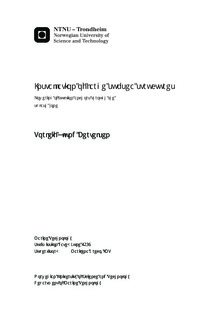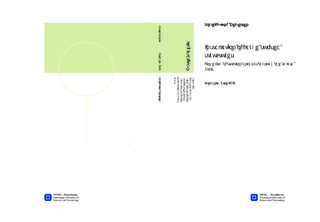| dc.description.abstract | In this thesis the dynamic air cushion pressure inside suction anchors during low-
ering through the splash zone has been studied. A non-linear continuity equation
for the air mass is used to establish a theoretical model for the dynamic air cush-
ion pressure. Buoyancy forces due to dynamic air cushion pressure inside the
suction anchors are calculated until the wave elevation inside the suction anchor
reach the top. At impact Wagner s wedge method together with Von Karman s
wetted length is used to calculate the impact force on the cone-shaped suction
anchor top.
Important parameters affecting the dynamic air cushion pressure and thus the
buoyancy forces have been investigated. Force measured in lifting wire during
splash zone transition of a single suction anchor is used as basis for comparison.
The parameters that are investigated are introduction of a time-varying lowering
velocity, changing characteristics of the ventilation hatch outlet and introducing
regular and irregular waves. By varying these parameters a best-fit comparison
with 2.5 [%] deviation between calculations and measurements have been ob-
tained.
Further, a comparison between theoretical calculations and force measurements
from a lifting operation of a subsea structure with suction anchors as foundation
has been performed. The buoyancy forces calculated prior to impact are due to
the dynamic air cushion pressure alone. The total force in the lifting wire for
this phase are corresponding well to the magnitude of the measured force.
During this comparison the effect of changing perforation ratio clearly show an
increase of buoyancy forces for decreasing size of ventilation hatch. Including
both inflow and outflow of air from the suction anchors when oscillating in large
waves have also been studied. When comparing with force measurements the im-
portance of including both inflow and outflow of air to account for both suction
and compressive pressure has been shown. This lead to negative and positive
buoyancy forces respectively.
Long crested waves accounting for wind and swell sea are calculated with the
JONSWAP- and Torsethaugen-spectra. By using empirical formulas for the lim-
iting case between wind and swell sea it is shown that wind sea is the dominating
part for the sea state measured during splash zone transition of the suction an-
chors.
Using Wagner s wedge model together with Von Karman s wetted length for cal-
culating impact force on a flat suction anchor top is also performed. Impact
forces with impact angles in the range of 5-15 degrees between the wedge-shaped
water and top overestimate the force compared with measurements. A best-fit
for the impact forces with the measurements has been obtained with deadrise
angle of 17.5 [deg] in addition to impact forces calculated with a time-varying slamming coefficient.
Possible resonant phenomena connected with oscillations of suction anchor and
pressure measurements at impact have been studied. Simplified models for cal-
culating A) natural period of oscillating air cushion, B) piston mode of water
column and C) coupled piston mode of air cushion and water column has been
developed. These have been compared with oscillation-period of pressure mea-
surements observed after impact of a single suction anchor. These calculations
have also been compared with oscillations of the suction anchor observed from
videos of experiment. Case B) proved to give the most similar results with the
suction anchor oscillations while case A) and C) were not in the proximity of
the observed oscillations. This showed that the air cushion were not causing any
resonant motion.
Using a common safety criterion for avoiding slack in lifting wire, the calculation
model have been used to give a recommendation for perforation ratios for the
suction anchors used on the installation of the subsea structure studied here.
Perforation ratios in the range 1-3[%] used on suction anchor with diameters in
the range 3-6[m] proved to be well within the slack-wire limit.
When using the theoretical model developed in this thesis a design recommen-
dation for using ventilation hatches with a certain height have been made. Also
uniform hatches are advised to ensure as similar conditions as possible for outflow
and inflow of air. | |

